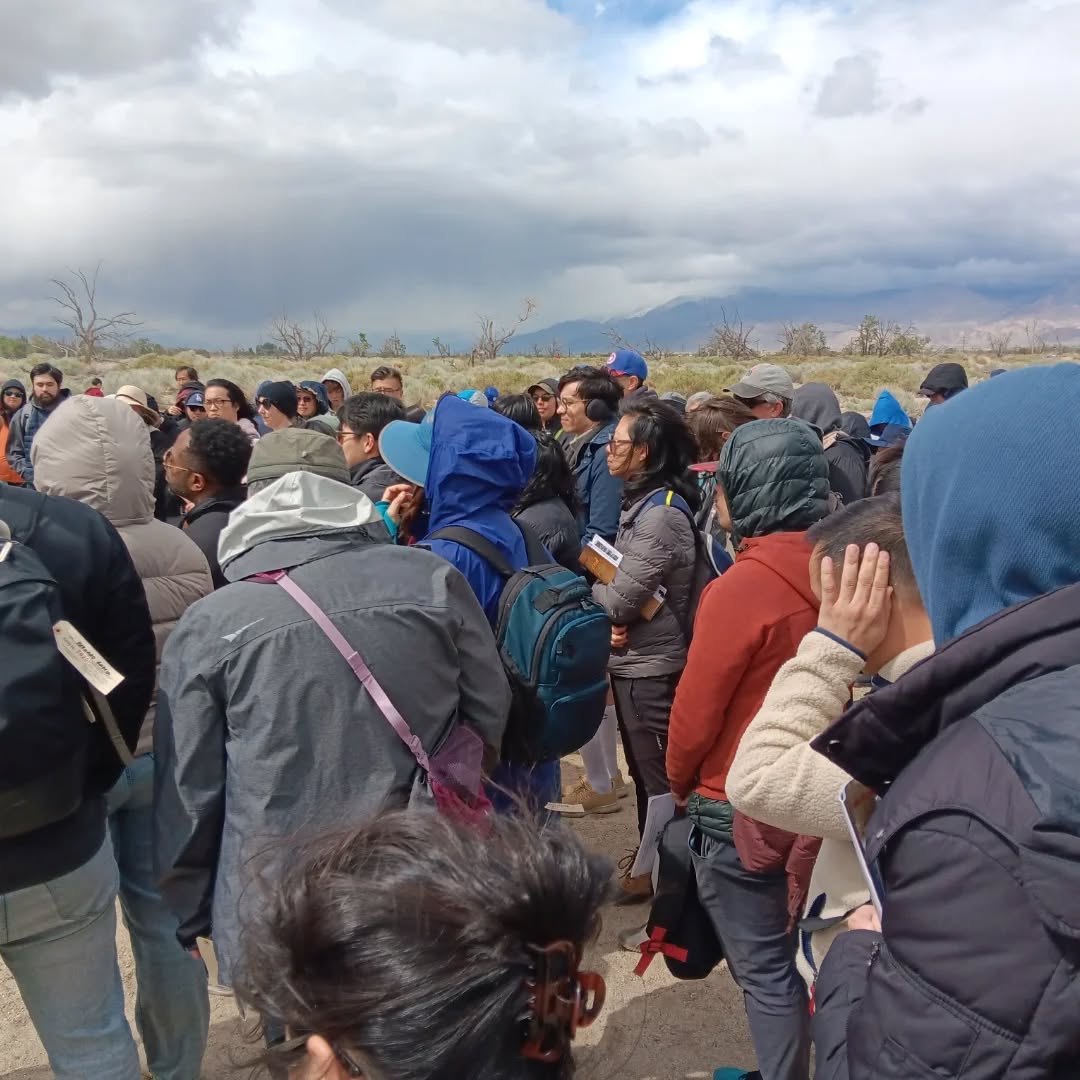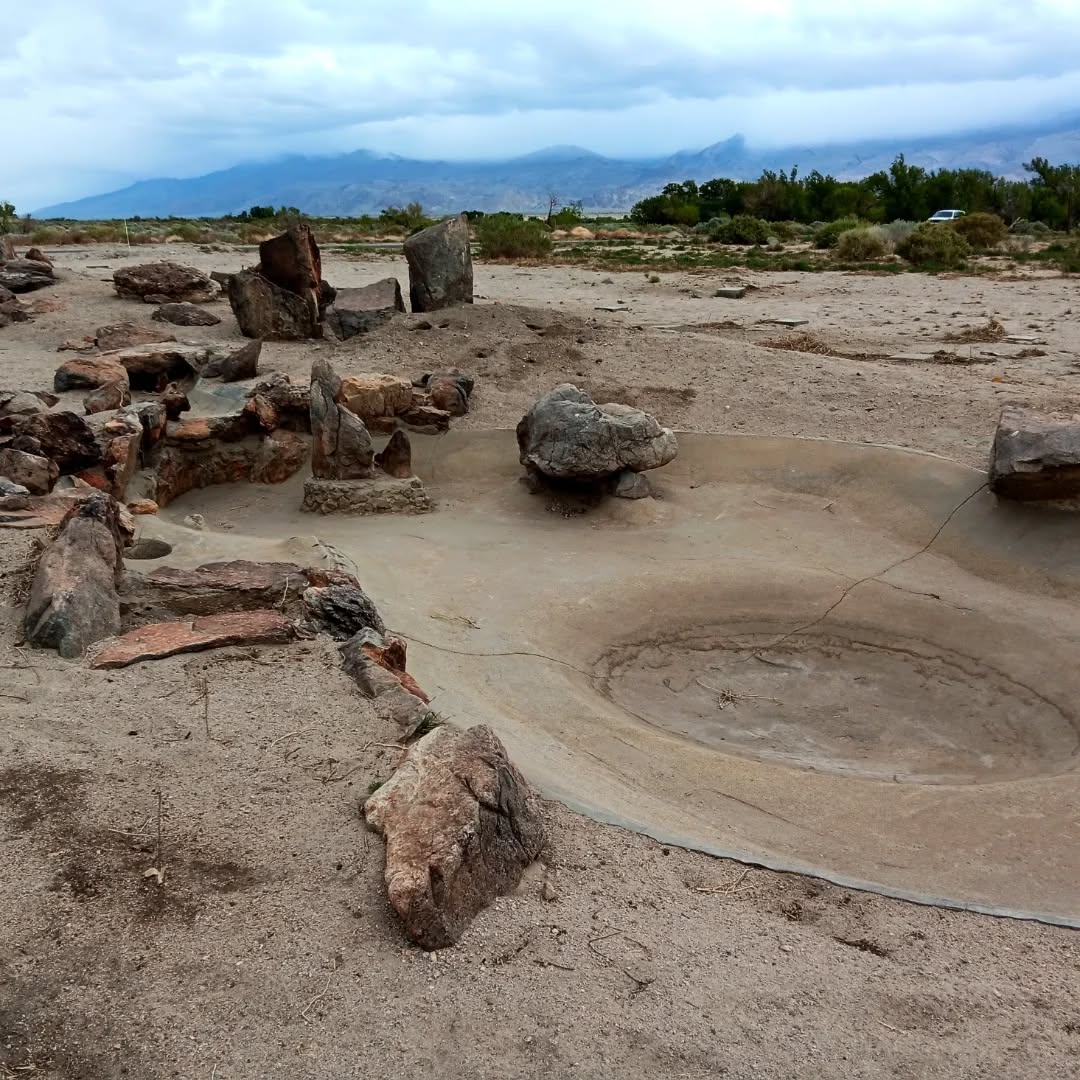‘So it doesn’t happen again’: Faith, memory, and the Japanese American pilgrimage to Manzanar
VALLEY FORGE, PA (05/27/2025)—“I was born in the Manzanar camp in January 1944,” said Bill Watanabe, a member of the Evergreen Baptist Church San Gabriel Valley, a Japanese American congregation in La Puente, Calif. His parents—farmers who had worked in the San Fernando Valley—and three older brothers were incarcerated there in March 1942. In September 1942, Bill’s older brother Takeshi passed away. He had serious medical needs that could not be addressed in the camp, which, coupled with low-quality, generic food and harsh desert climate, caused him to become weaker and die at the age of two.
In 1944, Bill’s parents were put in an impossible situation. Bill’s father was asked to renounce any connections to Japan and enlist in the U.S. Army. His mother gave up her U.S. citizenship, fearing that the family would be split. As a result, the family was sent to a higher-security camp, Tule Lake. After the war ended, they were able to return to the farm, unlike many others who had lost everything. Traumatized, they did not discuss the experience with their children. “They never talked about how it actually felt, or how they were impacted by being forced into the camps, at least, I never heard it,” recalls Bill.
This year marks the 80th anniversary of the Manzanar camp closing and the centennial anniversary of the founding of the Evergreen Baptist Church of Los Angeles, a church which has close links and shared heritage with the San Gabriel Valley church. To honor these events, the church’s congregation partnered with Fuller Theological Seminary’s Asian American Center and Little Tokyo Historical Society to organize a pilgrimage to the Manzanar camp.

Marking the 80th anniversary of the closing of Manzanar, a camp in the high desert of California where thousands of Japanese Americans were forcibly interned during World War II, congregants from California’s Evergreen Baptist Church San Gabriel Valley, a Japanese American congregation, joined hundreds of others on a recent pilgrimage to the somber location.
Many of the pilgrims are survivors of the camps, or survivors’ descendants. Bill Watanabe was one of the 140 people in this group at Manzanar this year; the camp site had 2000 visitors that day, reflecting the fact that the incarceration is still remembered by the Japanese American community and their allies. ABHMS’ National Coordinator for Asian Ministries Rev. Michele Turek participated this year as well.
Faith behind barbed wire
The forced removal and incarceration of over 120,000 Japanese Americans from the West Coast was authorized by President Franklin D. Roosevelt signing Executive Order 9066 in February 1942, following the attack on Pearl Harbor in December 1941 and the U.S. declaration of war on Japan. The Executive Order targeted nearly all people of Japanese ancestry on the West Coast—including U.S. citizens, legal residents, children, and elders—regardless of any actual connection to Japan. The authorities did not conduct any hearings, trials, or individual investigations before removing people from their homes. (German or Italian Americans were not persecuted to the same extent, despite the U.S. declaring war on Germany and Italy, as Japan’s allies, shortly after it declared war on Japan.)
Manzanar, located in California’s Owens Valley, was one of the largest internment camps; 11,000 people, often entire families, were detained there under military guard, behind barbed wire. Often located in remote and desolate places, camps were also set up in Tule Lake in California, Gila River and Poston in Arizona, Jerome and Rohwer in Arkansas, Minidoka in Idaho, Topaz in Utah, Heart Mountain in Wyoming, and Granada in Colorado.
Perceived to be less of a security risk, they were allowed to build churches out of scrap wood and tarpaper, hold regular worship services, baptize their children, receive pastoral care (Christian clergy were sometimes let into the camps as chaplains), and sing hymns in English and Japanese. For many incarcerated Japanese American Christians, faith became a theology of endurance—a quiet, persistent hope rooted not in deliverance from suffering, but in God’s presence amid injustice.
The conditions at the Japanese American incarceration camps during World War II were dehumanizing and deeply traumatic. People were housed in poorly constructed, overcrowded barracks and fed low-quality food. The U.S. government euphemistically called them “relocation centers,” but they functioned as militarized prisons surrounded by barbed wire and armed guards from 1942 to 1946. Families experienced trauma and humiliation, and loss of property, jobs, and communities compounded the hardship.
Japanese American Baptists were faithfully supported by Victoria Swanson, a home missionary from the Women’s Home Mission Society. Deeply engaged in collaboration with Japanese American Baptist churches before World War II, she became a staunch advocate for the interned; for example, she pleaded that college students be released and allowed to continue their education. One of those students was named Mariko Nakagawa; her descendants are members of the Evergreen congregation today. After the war, Swanson advocated at the National Council of Churches “when they were trying to decide whether to reopen the Japanese churches,” said Rev. Jason Ashimoto, senior pastor of the Evergreen Baptist Church of Los Angeles. “The leadership was suggesting that Japanese Americans are not allowed to have their own churches to help integrate them into white American churches to combat racism, to build relationships.”
Ashimoto described Swanson as a powerful force. “She advocated for reopening Japanese American churches. There’s some correspondence between her and John Thomas, Director of Cities at ABHMS and Ralph Mayberry, who was the regional minister for Los Angeles City Mission Society back then. She was giving Ralph a piece of her mind. She was kind of stirring up a little trouble, but she was really advocating for the reopening of the Japanese churches,” explained Ashimoto. “And then she served in the [Evergreen] congregation. She married a Japanese American pastor, Reverend Yamamoto. And she became ordained. She became Reverend Virginia Swanson Yamamoto.”
The church’s longstanding partnership with ABHMS is important to the congregation. “It feels like Rev. Michele Turek is a descendant of that same ministry lineage,” Ashimoto reflected. “She’s part of the same mission organization that supported Evergreen Baptist Church and the broader Japanese American Christian community during World War II. And here she is, with us now, on this journey of remembrance.”
Then and now: Echoes of injustice
Manzanar is the closest camp to Los Angeles, and it is maintained by the National Park Service, which built a visitor center, constructed exhibits, and recreated the barracks. “The Japanese American community, at least in Los Angeles, takes a pilgrimage to Manzanar every year,” explained Ashimoto. The Manzanar Committee, formed in 1970, has been organizing annual pilgrimages to raise awareness of Japanese American incarceration during the war. At this year’s pilgrimage, many speakers at the site of the Manzanar camp reflected on the historical trauma of incarceration and its troubling echoes in current U.S. policy.

Ruins of Manzanar, an internment camp for Japanese Americans targeted for imprisonment by the U.S. government at the outset of America’s involvement in World War II.
Ashimoto noted deep frustration within the Japanese American community, especially in response to the renewed use of the Alien Enemies Act—a law originally used to justify their own wartime imprisonment. “We’re watching the same playbook being used again,” he explained, pointing to policies targeting immigrants, as well as actions against American Arab and Muslim communities. “Within the Japanese American community, there is a lot of anger and fear and frustration because we see the same exact steps that were taken to incarcerate our community are being taken again.”
Today, fear and nationalism continue to operate through similar logics. The so-called “Muslim ban” in 2017 (Executive Order 13769) reflected similar xenophobic and racist sentiments against Muslims. In 2025, the Trump administration cited the Alien Enemies Act in a legal filing against detained Venezuelans. (The Supreme Court recently extended a block on that attempt.) Groups like the Japanese American Citizens League (JACL) and civil rights advocates publicly
“Ever since 9/11 we have had a significant contingent from the Muslim and Arab community attending the pilgrimage, and we do support them. And when I say we, I mean people who plan the pilgrimage support them and want to let them know that this shouldn’t happen to them,” explained Bill Watanabe.
Like Muslim and Arab Americans, Asian Americans are sensitive to how global events often cause racist sentiments against them to rise. Tim Tseng, director of Asian American Christian History Institute at Fuller Seminary’s Asian American Center, observed that people in the community are wary of the current “tariff war” with China.
“Many people are looking at how the US-China relationship is deteriorating, and there’s a lot of concerns about the potential rise of anti-Asian discrimination here. In the United States, you have this very anti-immigrant sentiment. We’re waiting to hear more voices from the church to speak up [against it].”
In April 2017, members of the Fuller seminary went on a pilgrimage to Manzanar to mark the 75th anniversary of the creation of the camps. They created a series of “Neighbor” videos with their reflections. The videos are accompanied by an introduction that reads: “For the whole law is summed up in a single commandment, ‘You shall love your neighbor as yourself’” (Galatians 5:14).
This scriptural commitment infuses the work of Rev. Ashimoto, Tim Tseng, and Bill Watanabe. They all emphasized that remembering what happened at the camps is essential so that it does not happen again—not just to Japanese Americans, but to any group. “My daughter and I, we have gone to Manzanar together,” said Watanabe. “And so eventually, I hope to be able to bring my granddaughters to Manzanar, too. It’s important that people learn what happened at Manzanar, so it doesn’t happen again—not to us, not to anyone,” he concluded. His desire to bring his granddaughters to Manzanar is more than family tradition—it is a declaration that historical memory must live on, lest history repeat itself.
In the same spirit, the American Baptist Historical Society has been working to create a curated digital collection of records documenting both the experience of Japanese Americans and the ministry of Northern Baptists with and among Japanese Americans, 1941-1946. An eight-panel traveling exhibit will be unveiled at the 2025 Biennial Mission Summit of American Baptist Churches USA in Omaha, and an online exhibit will provide a more extensive look at the experience of Japanese American Baptists during World War II.
To learn more about the imprisonment of Japanese Americans during World War II, watch the ABHMS-produced video, “A Church Stands with Its People.” To support the mission and ministry of ABHMS, visit here.
By Rev. Dr. Anna Piela, ABHMS’ senior writer and associate editor at The Christian Citizen.

